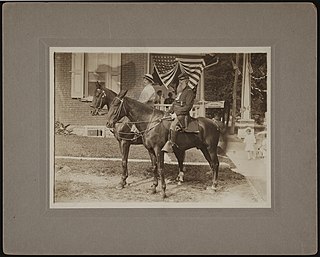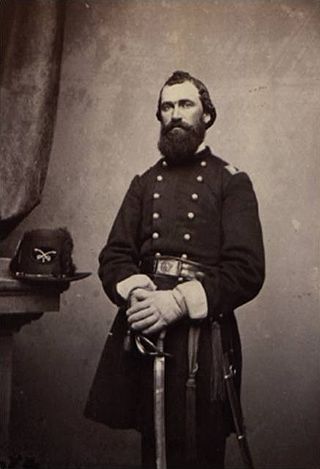
The Army of Northern Virginia was the primary military force of the Confederate States of America in the Eastern Theater of the American Civil War. It was also the primary command structure of the Department of Northern Virginia. It was most often arrayed against the Union Army of the Potomac.

The First Battle of Bull Run, also called the Battle of First Manassas by Confederate forces, was the first major battle of the American Civil War. The battle was fought on July 21, 1861, in Prince William County, Virginia, just north of what is now the city of Manassas and about thirty miles west-southwest of Washington, D.C. The Union Army was slow in positioning themselves, allowing Confederate reinforcements time to arrive by rail. Each side had about 18,000 poorly trained and poorly led troops. The battle was a Confederate victory and was followed by a disorganized post-battle retreat of the Union forces.

Turner Ashby Jr. was a Confederate cavalry commander in the American Civil War.
The Army of the Shenandoah was a field army of the Union Army active during the American Civil War. First organized as the Department of the Shenandoah in 1861 and then disbanded in early 1862, the army became most effective after its recreation on August 1, 1864 under the command of Philip Sheridan. The army's actions during the Valley campaigns of 1864 rendered the Shenandoah Valley of Virginia unable to produce foodstuffs for the Confederate States Army, a condition which would hasten the conclusion of the American Civil War.

The Battle of Hoke's Run, also known as the Battle of Falling Waters or Battle of Hainesville, took place on July 2, 1861, in Berkeley County, Virginia as part of the Manassas campaign of the American Civil War. Notable as an early engagement of Confederate Colonel Thomas J. Jackson and his Brigade of Virginia Volunteers, nineteen days before their famous nickname would originate, this brief skirmish was hailed by both sides as a stern lesson to the other. Acting precisely upon the orders of a superior officer about how to operate in the face of superior numbers, Jackson's forces resisted General Robert Patterson's Union forces briefly and then slowly retreated over several miles.
The Stonewall Brigade of the Confederate Army during the American Civil War, was a famous combat unit in United States military history. It was trained and first led by General Thomas J. "Stonewall" Jackson, a professor from Virginia Military Institute (VMI). His severe training program and ascetic standards of military discipline turned enthusiastic but raw recruits into an effective military organization, which distinguished itself from the First Battle of Bull Run in 1861 to Spotsylvania Court House in 1864. Its legacy lives on in the 116th Infantry Brigade, which bears the unofficial nickname "Stonewall Brigade," and in several living history reenactment groups.

Robert Patterson was an Irish-born American military officer who served as a United States Army major general during the Mexican–American War, and a Union Army major general during the American Civil War. During the Mexican-American War, he served as second in command to Winfield Scott and fought at the Siege of Veracruz and the Battle of Cerro Gordo.

The Army of the Shenandoah was a field army of the Confederate States Army active during the American Civil War. It was created to defend the Shenandoah Valley of Virginia from Union Army attacks during the early months of the war. The army was transferred to reinforce the Confederate Army of the Potomac at the First Battle of Bull Run, which was the only major engagement of the war it participated in. After the battle, the army was merged into the Army of the Potomac.

The 11th Pennsylvania Infantry Regiment was a Union army regiment that participated in the American Civil War. It had the distinction of being the oldest unit in continuous service from Pennsylvania.

The eastern theater of the American Civil War consisted of the major military and naval operations in the states of Virginia, West Virginia, Maryland, and Pennsylvania, the national capital in Washington, D.C., and the coastal fortifications and seaports of North Carolina. The interior of the Carolinas were considered part of the western theater, and other coastal areas along the Atlantic Ocean were part of the lower seaboard theater.

The 23rd Pennsylvania Volunteer Infantry was an infantry regiment that fought in the Union Army during the American Civil War. Known for its colorful uniforms based upon the popular French Zouave style, the regiment served in the Eastern Theater.

The 46th Pennsylvania Volunteer Infantry was a Union Army regiment in the American Civil War. It served in both the Eastern and Western Theaters, most notably at the 1862 Battle of Cedar Mountain and during the 1864 Atlanta Campaign. During the war, the regiment lost 17% of its strength through combat losses and disease.

The 2nd Virginia Infantry Regiment was an infantry regiment raised in today's western Virginia and what became West Virginia during the American Civil War for service in the Confederate States Army. It would combine with the 4th, 5th, 27th, and 33rd Virginia infantry regiments and the Rockbridge Artillery Battery and fight as part of what became known as the Stonewall Brigade, mostly with the Army of Northern Virginia.

The Bull Run campaign, also known as the Manassas campaign, was a series of military engagements in the Eastern Theater of the American Civil War in 1861.

Jacob C. Higgins (1826–1893) was a commander of Pennsylvania troops who participated in both major military conflicts of his time, the Mexican–American War and the American Civil War. Among his Civil War commands, he guided the 125th Pennsylvania Infantry regiment under heavy fire during the Battle of Antietam and likewise during the Battle of Chancellorsville. Following the muster out and return home of the 125th PA, the Gettysburg Campaign sent cavalry under Confederate General John D. Imboden to threaten vital railroad resources at Altoona and iron production facilities in the Juniata River watershed; in response, Emergency Militia was organized by Colonel Higgins and minimized this northwestern incursion.

The 58th New York Infantry Regiment, also called the Polish Legion, was an infantry regiment of United States Volunteers in Union Army service during the American Civil War. The regiment was composed almost entirely of immigrant volunteers: Poles, Germans, Danes, Italians, Russians, and Frenchmen, most of whom were recruited in New York City in 1861.
The 2nd Pennsylvania Infantry Regiment was a Union army regiment that participated in the early part the American Civil War.

The 202nd Regiment Pennsylvania Volunteer Infantry was an infantry regiment of the Union Army in the American Civil War. Raised in the Harrisburg area and the Coal Region in August and September 1864, the regiment was sent to the Manassas Gap Railroad to guard it against the attacks of Confederate partisan rangers led by John Mosby. Following the Union victory at Battle of Cedar Creek, the regiment helped break up the now unneeded railroad and moved to Alexandria to guard the railroad there. After the end of the war, the regiment served in the Coal Region to suppress labor unrest, and was mustered out in mid-1865.

The 24th Pennsylvania Volunteer Infantry was a three-month infantry regiment that served in the Union Army during the American Civil War.

The 21st Pennsylvania Volunteer Infantry was a three-month infantry regiment that served in the Union Army during the American Civil War.
















